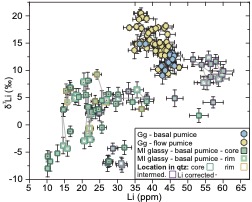Neukampf, J. ; Laurent, O. ; Tollan, P. ; Bouvier, A.S. ; Magna, T. ; Ulmer, P. ; France, L. ; Ellis, B.S. ; Bachmann, O.
Geochimica et Cosmochimica Acta, 2022, 326, 56-76
`Voir en ligne : https://doi.org/10.1016/j.gca.2022.03.037

Abstract :
Lithium and hydrogen are volatile elements which diffuse rapidly in crystals and melt, making them powerful geochemical tools to reconstruct geological processes that take place on short time scales, such as syn- and post-eruptive degassing. Although the dynamics of hydrogen are fairly well understood to better constrain such processes, the assessment of Li behaviour within the magma reservoir relevant for ascent-related degassing still lacks detailed evaluation. Here, the first in situ Li concentrations and isotopic compositions (using SIMS analysis) of rhyolitic quartz-hosted, naturally glassy and crystallised melt inclusions (MIs) and groundmass glass (Mesa Falls Tuff, Yellowstone) are used to reconstruct Li elemental and isotopic evolution in the magma reservoir. Lithium concentrations in quartz-hosted glassy MIs (10–61 ppm) from a fallout deposit overlap with their groundmass glass (32–46 ppm) and their host quartz (8–15 ppm). Crystallised MIs from a later erupted flow pumice clast sample have higher Li concentrations (8–190 ppm) compared to the groundmass glass (32–51 ppm) and their host quartz (15–24 ppm). Lithium content in quartz from the early erupted sample is relatively homogenous, whereas it is up to a factor of two higher and heterogeneous in the later erupted sample, with a simultaneous increase in Li versus a decrease in H towards crystal rims. The d7Li difference (expressed as D7LiMI–glass) between MIs (-8.0‰ to + 12.3‰) and groundmass glass (+9.0‰ to + 20.5‰) of two pyroclastic deposits reaches up to 29‰. Glassy MIs are internally heterogeneous in d7Li and Li abundance. The cores of the glassy MIs record the d7Li of the least modified melt during entrapment and the data distribution can be modelled by equilibrium fractionation between the melt and vapour phase during early opensystem degassing in the magma reservoir. Late degassing during eruption triggers Li–H diffusional exchange between quartz and melt, as the degassing of H2O and the accompanying pressure change trigger H diffusion out of the host quartz and the MIs, which is charge balanced by inward Li diffusion. This results in the modification of Li contents in quartz and d7Li values in the rims of the glassy MIs. Crystallised MIs reflect the loss of H2O from the MIs and the resulting enrichment of Li during the crystallisation. Additionally, the variations of d7Li in the groundmass glass can be explained through modelling by kinetic fractionation between the melt and vapour during late stage open-system degassing linked with magma ascent.



